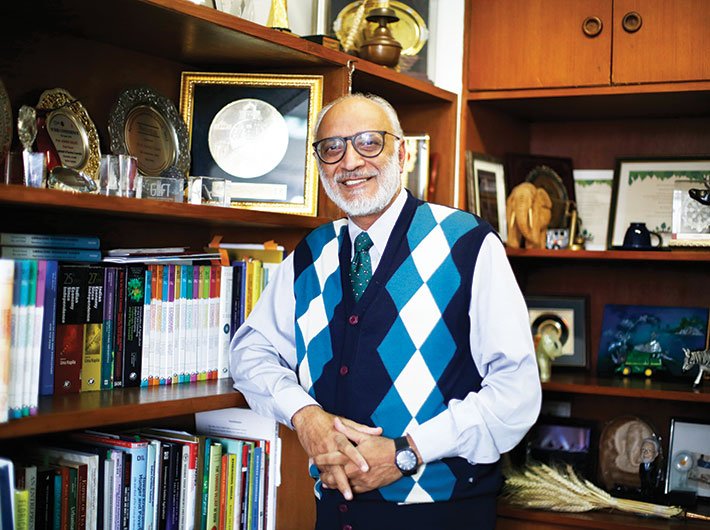As they say, nothing is impossible in the world if you have the determination and willingness to do things. China doubled its farmers’ income from 1978 to 1984. The real income increased at 15 percent per annum and within six years they reduced the poverty by half. Doing that requires strategy, clear vision and a champion to implement policies. I doubt whether the current government has this vision and ample resources.
A committee called Doubling of Farmers’ Income headed by Ashok Dalwai has written 14 volumes on the subject. These documents remind me of Albert Einstein’s famous quote, “If you can’t explain it simply, you don’t understand it well enough.” They have given more than 300 recommendations that the government needs to implement. But can they do it? And when will they do it?
If the sky falls, we shall catch larks
The prime minister, while addressing a rally of farmers in Bareilly, said that it is his dream to double the farmers’ income by 2022. When the PM expressed his dream, he did not mention whether he was talking about real income or the nominal income. But when the committee was set up it came out with a report that clearly stated that the objective is to double farmers’ real income. That is a real challenge.
READ: Double trouble
The two NSSO surveys of 2002-03 and 2012-13 show that the real income of a farmer increased by only 3.5 percent in this period. Meanwhile, the nominal income at the all-India level increased by 11.8 percent per annum compound rate during this time frame. After 2013, there has been no NSSO survey and the NABARD survey 2017 is not yet out. As per the calculations, farmers’ real income growth has gone down to 2.2 percent from 3.5 percent. In this situation when we are already witnessing a slump, the target of doubling farmers’ income would mean raising the compound annual growth rate to 10.4 percent, literally a three-fold increase.
This seems almost an impossible task as it would require massive investment and overhaul of existing policies. Agriculture minister Radha Mohan Singh recently said that the government is very clear that the first right over its treasury is of a farmer. The DFI report clearly states that it needs an additional investment of Rs 6,40,000 crore to achieve the target. These estimates are based on 2011-12 data. In the current scenario, however, it has to be doubled. We need Rs 13 lakh crore of additional investment in the agriculture. Our total budget is Rs 25 lakh crore. It means half of that allocation should go to agriculture. Is it possible?
Even if we imagine that we are able to achieve the objective of doubling real income by 2022, the big question is how we will absorb the massive production of agriculture commodities. Will it be exported or absorbed by the system? Every year, onions and potatoes are dumped on roads. They are sold at less than Rs 5 per kg in mandis. The farmers are not able to recover their cost. A similar situation exists for pulses too, which are always short in supply. Even after a good harvest tur dal prices collapsed and were sold below the minimum support price (MSP). We are certainly not incentivising farmers to produce more.
Today, we are just half of what China is producing. India’s total gross cropped area is 198 million hectares, while China has 166 million hectares. Still, China’s cereal production is double that of India’s. They produce four times more fruits and vegetables and eight times more meat as compared to our country. And all this is happening when they have less land and only 30 percent of their workforce in agriculture.
Change in mindset
The whole system is geared towards the consumers. As the price rises, the first thing we do is to control import and export. There should be a ban on the ‘ban on exports’. In 2016-17, we reported good pulse production. It registered a growth of 65 percent with a record production of 23 million tonnes. The price tumbled 15-20 percent below MSP. We banned the exports, stocking was limited to the private sector and they were not allowed to deal in future markets. However, the imports continued. In this process, we made the farmer poorer as he could not recover his cost.
It could be avoided if we abolish stocking limits on private trade. Second, by allowing private players to deal in future markets; third, by opening up their exports; fourth, by building a buffer of two million metric tonne and fifth by imposing import duty to ensure that the landed prices are not below the MSP.
Access to market
Market reforms must precede productivity question. Why a farmer has to go to the APMC market to sell his produce? Why can‘t consumers or companies directly buy from farmers? Why should he pay the mandi fees? Commission agents are a big scam in the country. There are other market systems which can help farmers, like we have in the dairy sector. Agricultural commodities can be graded, standardised and packaged. Farmers will get the right value of their produce. Southeast Asian countries process 25 percent of their agricultural produce. In our country, it is just five to seven percent. The government should provide 50 percent cost to those who will create the backend structure in villages.
We are missing out on food processing and market linkages. So far there was no investment in agro processing industries. This time it has increased to Rs 1,400 crore. The volatility of agricultural commodities can be controlled by linking farmers with industries and retail.
Productivity and climate change
More than 50 percent of the agriculture land is rain-fed. Considering the conclusions drawn by the economic survey, climate change can reduce annual farm income by 25 percent in the coming years. It suggests investing in irrigation and crop diversification. Ironically, we don’t have the progress report of the irrigation project where government promised completing 99 projects by 2019 through NABARD funding. Even in last year’s budget, Rs 5,000 crore was announced for a micro-irrigation project. Surprisingly, it was approved one month back.
Technology revolution
Green Revolution is the biggest event of the agriculture sector. At that time Chidambaram Subramaniam fought in the parliament to import 18,000 million tonnes [seeds of two varieites of wheat, ‘Lerma Rojo 64A’ and ‘Sonora 64’] from Mexico. The decision was opposed. Today, we have a buffer stock of food grain because of one bold move. Thereafter, we witnessed Operation Flood. Taking last 15 years into account, it was former PM Atal Bihari Vajpayee who took the decision to allow Bt cotton. Before Bt cotton was introduced we produced 12-13 million bales of cotton. Today, we are producing 37 million tonnes, becoming the largest producer and exporter of cotton. Gujarat was the biggest beneficiary. Until 2002-13, the agricultural growth rate of Gujarat was eight percent per annum. It was an achievement which none of the other states in India ever witnessed. It was higher than the Green Revolution days of Punjab. Narendra Modi reaped the maximum benefit by winning three state elections. He got rural votes. It gave prosperity and political gains. Everything that is new comes with resistance. We have to learn to deal with it. We need boldness and vision. We spend only 0.7 percent of the GDP on research.
Right price
The Commission for Agricultural Costs and Prices (CACP) recommends MSP by looking at references like demand-supply, cost of production and international/domestic prices. The comprehensive cost of production has several aspects. It includes what the farmer spends from his own pocket (A2) and the family labour (FL) he puts in. But that is not the only expenditure of a farmer. He has to pay the rental value of land and tractor. It is called comprehensive cost (C2). The entire debate is 50 percent over that comprehensive cost. MSP based A2+FL is there for more than a decade now. It is no game-changer. Meanwhile, there is no official statement on C2+50%, which should be used as per the Swaminathan Commission report. In the last three years of the current NDA government, paddy and wheat MSP increase is less than five percent on an average. Since inflation rates are similar, the real procurement prices have been stagnant.
Direct benefit transfer
Much of the budgetary allocation in rural sector goes for safety nets – National Food Security Act and Mahatma Gandhi National Rural Employment Guarantee Act (MGNREGA). It together accounts for Rs 1,93,339 crore against budget for rural roads, irrigation, power supply, research and development which adds to Rs 32,103 crore. Almost Rs 94,000 crore goes into subsidies on fertilisers, crop insurance and credit. The problem with this type of allocation is like putting the cart before the horse. The allocation tilts heavily towards safety nets and subsidy instead of investment. Going by this approach, farmers’ income cannot be doubled by 2022. We are giving wrong signals to a farmer and that’s why we are getting wrong results. Subsidy should be transferred directly to their Jan-Dhan Yojana accounts through direct benefit transfer.
Gulati spoke to Archana Mishra.
(The article appears in the April 15, 2018 issue)

